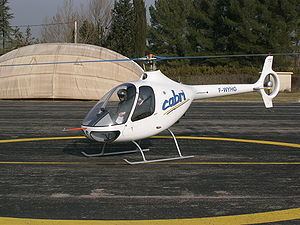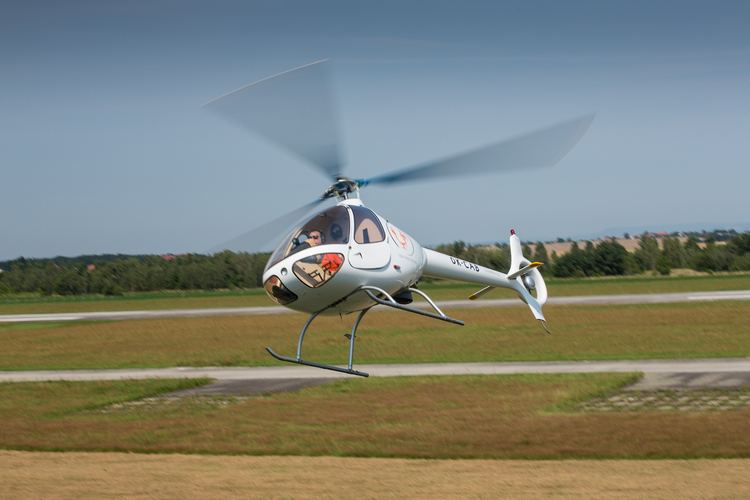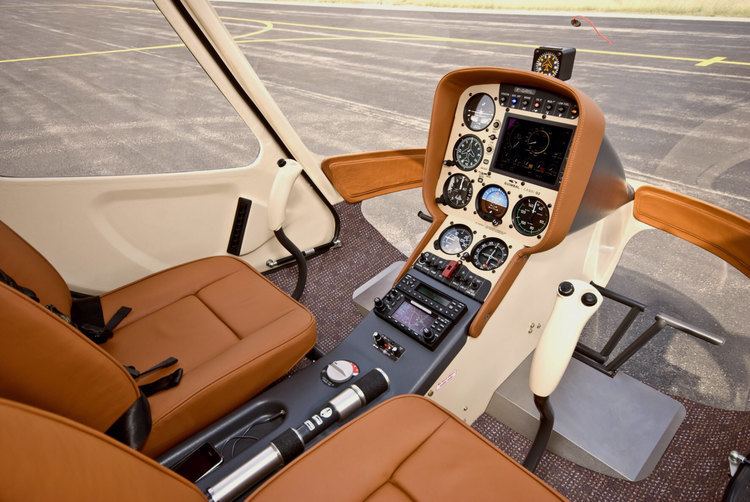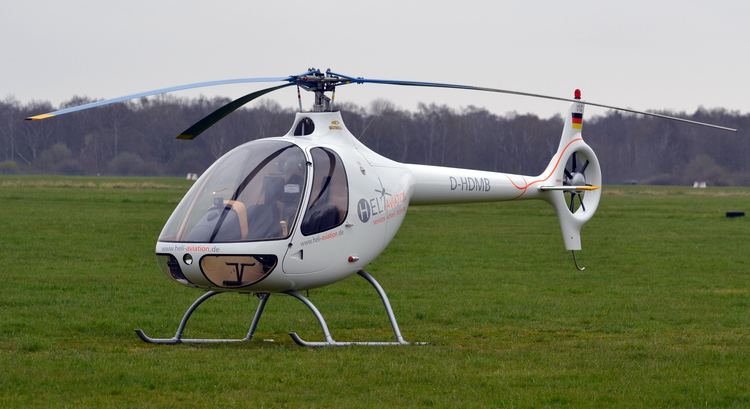Top speed 185 km/h Length 6.31 m Weight 420 kg | Range 700 km Wingspan 7.2 m Unit cost 284,000–284,000 EUR | |
 | ||
Similar Dynali H2S, GEN H 4, Groen Hawk 4 | ||
Building a guimbal cabri g2
The Guimbal Cabri G2 is a two-seat light piston-engined helicopter produced by Hélicoptères Guimbal. It was designed by Bruno Guimbal, a former Eurocopter engineer. Having its origins in the 1980s, the first demonstrator flew in 1992. Following the granting of regulatory approval, the Cabri entered commercial service in 2008. In addition to its use within the general aviation sector and as a training rotorcraft, the Cabri G2 has also been used as the basis for unmanned aerial vehicles (UAVs).
Contents
- Building a guimbal cabri g2
- Guimbal cabri g2 start up tutorial
- Development
- Design
- Operational history
- Specifications
- References

Guimbal cabri g2 start up tutorial
Development

During the 1980s, Bruno Guimbal, while working at Eurocopter upon the Eurocopter AS365 Dauphin and Eurocopter EC120 Colibri helicopters, decided to independently pursue the development of a two-seat piston engine helicopter. This rotorcraft would incorporate numerous safety-related and general technological advances commonly applied to larger turbine-powered rotorcraft, but typically absent from piston-engine helicopters. These technologies included Eurocopter's Fenestron anti-torque shrouded tail rotor and Spheriflex main rotor, in addition to a composite fuselage.
During the early 1990s, Eurocopter elected to sponsor the program, as well as providing technical assistance during testing. In April 1992, the first prototype Cabri G2-01 conducted its maiden flight, which lasted for a total of 45 minutes. In 1996, this prototype set a world record. In 2000, Bruno Guimbal left Eurocopter to establish a new company, Hélicoptères Guimbal, in order to certify the Cabri G2 and to place the type into commercial production. To this end, research and production facilities were set up in Aix-en-Provence Aerodrome, France.

At one point, it had been hoped to have the Cabri certified in 2003. In March 2005, the first production Cabri performed its first flight. Following a six-year development program and 300 hours of flight testing, the Cabri G2 received type certification from the European Aviation Safety Agency (EASA) in December 2007. The granting of EASA certification made the Cabri the first twin-seat piston engine to be certified in more than 30 years.

In September 2008, production was reported to have been planned to ramp up to one rotorcraft per month throughout 2009, rising to two per month in 2010. In 2014, a total of 28 Cabri rotorcraft had been produced and, following a phase of manufacturing expansion, 44 Cabris were delivered in 2015; while 56 have been projected for 2016. It is intended for lead times between the receipt of an order and deliveries to be less than twelve months.

Guimbal did not initially pursue enter into the North American market, having instead chosen to wait for demand from suitable customers to emerge. In February 2015, the Cabri G2 received type certification from the Federal Aviation Administration (FAA), clearing the way for operations within the United States. By February 2016, the Cabri had received certification in 24 countries.
Beginning in 2003, Eurocopter and Hélicoptères Guimbal cooperated on the development of the Orka 1200, a vertical take-off and landing unmanned aerial vehicle (UAV) intended for military use. In June 2005, Eurocopter and Hélicoptères Guimbal formed a joint venture, known as Vertivision, to develop, market, and produce unmanned variants of the Cabri G2, including prospective commercially orientated models. These UAVs shall reportedly make use of an advanced autopilot system, derived from the Eurocopter EC725; alternative powerplants are also under considered.
Design
The Cabri G2 is a two-seat light helicopter with a three-bladed fully articulated main rotor and a Fenestron-type tail rotor. The main rotor is designed to enable flight within a wide envelop of weather conditions, while the composite rotor blades are damage-tolerant and have no set life span. The use of the Fenestron has been credited as having made the Cabri noticeably quieter than competing rotorcraft such as the Sikorsky S-300, in addition to its favourable safety, handling, and maneuverability attributes. The Cabri uses a skid landing gear arrangement; unusually, the skids are attached to the fuselage by elastomeric mounts rather than being directly bolted on to reduce ground resonance and provide greater articulation. The fuselage features a damage-resistant all-composite monocoque construction, reducing weight and maintenance requirements while increasing strength.
The Cabri employs a side-by-side seating arrangement for a pilot and passenger, which is also ideal for training purposes, which is an intentional role for the type. Dual flight controls are typically installed, these can be removed without the aid of tools as required. The passenger seat can be removed if unnecessary or for greater storage space within the cabin. Various features for personal helicopter usage, such as an externally accessible 200-litre baggage compartment, power sockets within the main cabin, leather seating, and incidental under-seat storage, are also present. An unusual feature of the Cabri is a remote door locking system, which includes an immobilizer function; this has been reported as being a world-first. The Cabri is also the first light helicopter to feature a plasma ignition system, the first with a glass cockpit, and the first to be certified under TCDS 135 EASA regulations. Available options include air conditioning, various avionics configurations, moving map display, GPS system, cargo hook, automatically deployed floatation gear, and several maintenance tooling packages.
The Cabri powered by a single 180 hp (134 kW) Lycoming O-360 piston engine, which has been derated to 145 hp (108 kW). The engine incorporates a solid-state electronic ignition system which protects against over-speed upon startup and has greater reliability. The engine mounts also utilize vibration isolation techniques for increased crew comfort. The engine is positioned directly behind the cabin, making it easier to access for maintenance; while the engine exhaust is elevated above the tail boom in order to reduce noise and lower the risk of ground fires upon landing. The maintenance costs of the Cabri are claimed to be "very low", in part due to only three components on the rotorcraft being time-limited, all others being condition-limited instead. The cost per overhaul of the Cabri is half of that of comparable rotorcraft such as the Robinson R22.
At the core of the Cabri's avionics is the Electronic Pilot Management (EPM) system, the digital instrumentation of the aircraft's glass cockpit. Intended to be intuitive, the EPM uses three monitors to display critical aircraft and engine information, such as current power settings, engine/rotor RPM, fuel level, flight time, and sensor data. In the event of an EPM system failure, backup systems are present. Guimbal claim the Cabri G2 to be "the only piston helicopter designed from scratch with the safety of its occupants as top priority." As such, numerous safety features are present upon the aircraft, including the design of the main rotor, a crash-worthy design, four-way trim system, energy-absorbent structure/seats, automatic carburetor ice-protection system, crash-resistant fuel tank, and exceptional autorotation capabilities. During development, the safety, security, longevity aspects of the design were emphasized over the cost.
Operational history
On 19 September 2008, the first production aircraft was officially delivered to iXAir, a French training operator, during a ceremony at Aix-en-Provence Aerodrome; this aircraft being the first of an order of ten. US-based operator Precision Helicopters, who is also an overseas distributor for the Cabri, served as the launch customer for the North American market, having received their first Cabri in February 2014.
Following its national debut in 2011, the United Kingdom soon emerged as one of the major operating nations of the type, having 14 Cabris in service with various operators by February 2016; this has been projected to reach 28 by the end of 2016. In early 2015, Guimbal stated that the Cabri was in service with 32 operators worldwide, and that the firm presently had orders for another 100 aircraft. In 2015, it was also reported that 70 per cent of all Cabri rotorcraft sold to date had been for training purposes; Bruno Guimbal has claimed that: "I designed the Cabri to be the best trainer that you can imagine".
In 2006, the Cabri G2 set three world records in the sub-500 kg helicopter class. Altitude without a payload 6,658 m (21,844 ft); time to climb to a height of 3000 m (9840 ft) in 6 min 42 secs, and time to climb to a height of 6000 m (19680 ft) in 22 min 6 sec.
Specifications
Data from EASA Type Certificate Data Sheet, Guimbal, Blade
General characteristics
Performance
